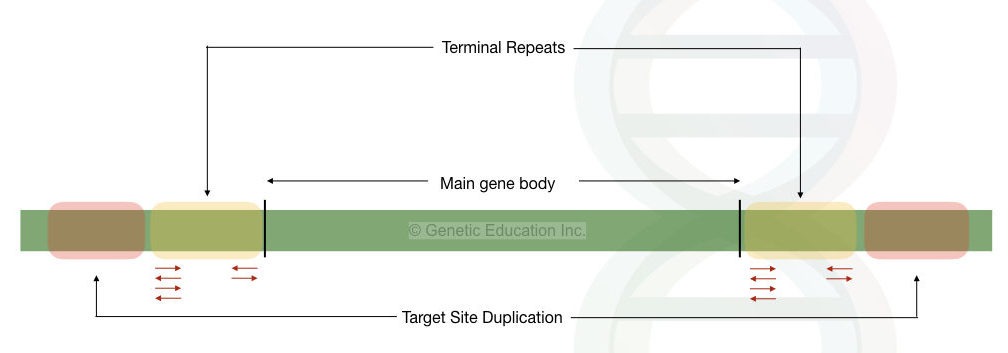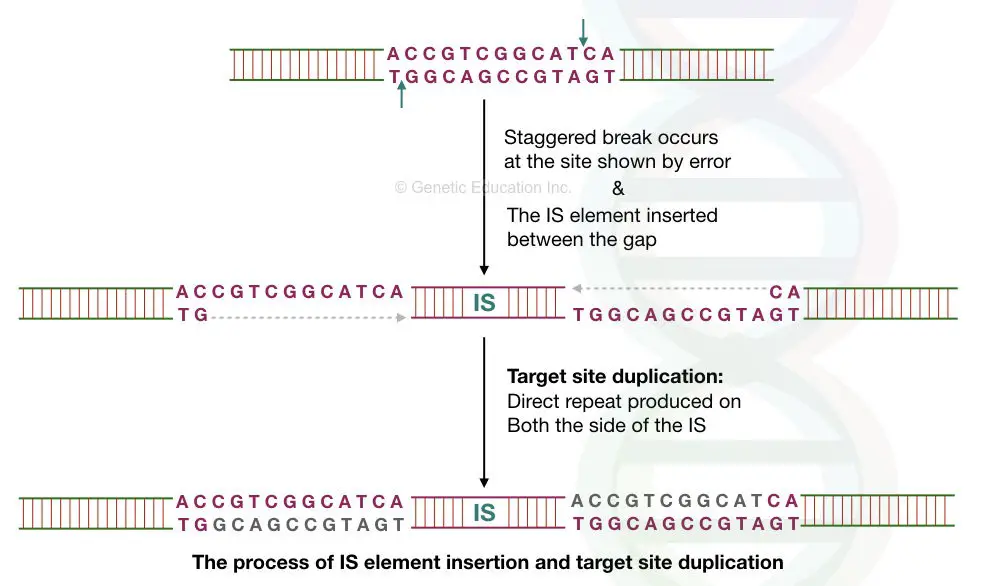“A typical transposon contains terminal repeats, gene body and target site duplication. Let’s explore the structure in detail.”
Transposons— or Transposable elements are the mobile genetic elements equipped with jumping properties. It can move within and among the genome and create new variations.
Both prokaryotes and eukaryotes contain transposable elements with similar structural elements. However, prokaryotic transposons contain one unique gene that helps them to survive.
That we will discuss later.
DNA transposons and retrotransposons are two types of transposons. We already have written an article on these topics. You can click the link and explore the complete reading list.
To better understand the present topic, I will only explain the transposon structure in detail in this article.
Stay tuned.
Key Topics:
Transposon structure
Transposable elements are unique in the structure. Along with a functional gene, they also carry additional unique sequence structures that differentiate them from either pseudogenes or functional genes.
As explained many times in various articles, a typical transposon has terminal repeats, a gene body and target site duplication. Notedly, this typical structure will remain the same in all the transposons.

Let’s discuss these three elements one by one.
Terminal repeats are present on both 3’ and 5’ ends of a transposon. It helps TE to recognize the transposase gene and excise it from its original location. Put simply, its main function is in transposition.
Terminal repeats:
Three types of terminal repeats are inverted terminal repeats, direct terminal repeats and long terminal repeats.
Inverted Terminal Repeats:
Inverted Terminal Repeats, short for ITRs or TIRs, are the most predominantly present in transposons. Particularly in DNA transposons, it’s present on both the terminal ends.
These are the very short repetitive DNA sequences that are present in an inverted orientation. Meaning, one end’s sequence is the reverse complementary of the other end’s sequence.
For instance, If there is a 5’ —ACGT— 3’ on one end then, there is a 3’ —TGCA— 5’ on the other end. Tn5 in prokaryotes and P elements in Drosophila are the best examples of ITRs. Tn5 and P elements in Drosophila are 19 to 25 and 31 bp long ITRs, respectively.
ITRs play a crucial role in transposase recognition by providing the binding site. It follows the non-replicative (cut-and-paste) mechanism of transposition in DNA transposons.
Long Terminal Repeats
Long Terminal Repeats, short for LTRs, are the unique property of the retrotransposons. Notedly, retrotransposons are commonly present in eukaryotes. LTRs are not inverted, but direct terminal repetitive sequences present on both the transposon ends.
For instance, if the LTR on one end is 5’ —ACTGACTG— 3’, the LTR on the other end would be 5’ —ACTGACTG— 3’. That means identical on both ends!
Ty elements in Yeast Gypsy in Drosophila are the classic examples of long terminal repeats. The length of Yeast’s Ty element is 340 bp whereas Drosophila’s gypsy elements are approx. 500 bp.
As it is present in the retrotransposons, it also has some additional functions. The key function of LTR is to help a transposon integrate into the genome. It also participates in reverse transcription and also possesses a promoter, enhancer or polyadenylated signal sequences.
Direct Repeats
Direct Repeats, short for DRs, are identical repetitive sequences present on both transposon ends after transposition. It generates staggered ends but is filled with the replication process.

For instance, IS elements in bacteria carry short direct repeats after transposition. However, it can not directly participate in the transposition process.
Gene body
Now, between the terminal repeats, a main transposon gene body is present. It may contain a single or many genes, depending on the organism and requirements. For instance, in bacteria, along with a transposase gene, an antibiotic resistance gene is also present.
Transposase gene
The main component of a transposable element which provides mobility to a TE, is the transposase gene. It recognizes the terminal repeat sequence, cuts from one location and is inserted into another genomic location.
Transposase alone performs nonreplicative transposition. Majorly, all the TEs carry the transposase gene.
Resolvase gene
Resolvase gene along with a transposase gene, helps in replicative transposition. It facilitates the co-integration and replication of transposons. For example, bacterial Tn3 TEs contain a resolvase gene.
Antibiotic resistance gene
Interestingly, bacterial TE also carries a special gene within the main body– an antibiotic resistance gene. This gene protects bacteria against a particular antibiotic.
TEs in prokaryotes, particularly in bacteria, can move between the circular chromosome and plasmids. So antibiotic resistance also spreads utilising the TE.
| Transposable element | Antibiotic resistance gene | Antibiotic |
| Tn3 | bla (beta-lactamase) | Ampicillin |
| Tn5 | nptII | Kanamycin |
| Tn9 | cat | Chloramphenicol |
| Tn10 | tet | Tetracycline |
| Tn21 | mer, sul, str | Mercury, Sulfonamides, Streptomycin |
| Tn7 | dhfr | Trimethoprim |
Other genes
In addition, the main body also contains other important genes like reverse transcriptase (retrotransposons), envelope protein etc. However, it may vary among organisms.
Table: a few genes present in TEs other than transposase and resolvase.
| Gene | Function |
| Integrase | Found in retrotransposons; integrates the reverse-transcribed DNA copy of the element back into the host genome. |
| Reverse transcriptase | Present in retrotransposons; synthesizes DNA from the RNA template. |
| Endonuclease | Makes a cut in the DNA, allowing the insertion of the transposon at the target site. |
| RNase H | Degrades the RNA strand of an RNA-DNA hybrid during reverse transcription, aiding in retrotransposon activity. |
| Gag | Encodes proteins that form virus-like particles in retrotransposons (e.g., in LTR retrotransposons). |
| Env | Found in some retrotransposons, especially LTRs, this gene encodes envelope proteins used for potential viral-like activities. |
| Poly A binding protein | Plays a role in the replication and movement of LINE retrotransposons, helping them integrate into the genome. |
Target Site Duplication
Target Site Duplication short for TSD is indeed not a part of a transposable element but incorporated at ends, after transposition. These are the short direct sequences, flanks the terminal repeats.
When a transposon is inserted in any genomic location, it will carry a few nucleotide sequences with it from that location and be inserted into another genomic location. These are known as TSDs.
I already have written a whole article on the complete process of Target Site Duplication, click the link and read the article.
Related articles:
Wrapping up:
So this is a general structure of transposable elements. This intact structure gives them mobility to transpose. It is, however, crucial to know that the ITR, TSD and gene body structure can vary among different TEs and organisms.
Transposable elements played a crucial role in the evolution process and are still doing their best in many organisms, excluding humans. They are essential for creating new alterations and allelic combinations.
I hope you enjoyed the article. Share the article and subscribe to our blog.
Sources:
Almojil D, Bourgeois Y, Falis M, Hariyani I, Wilcox J, Boissinot S. The Structural, Functional and Evolutionary Impact of Transposable Elements in Eukaryotes. Genes. 2021; 12(6):918. https://doi.org/10.3390/genes12060918.
Kidwell, G. “CHAPTER 3 – Transposable Elements.” ScienceDirect, Academic Press, 1 Jan. 2005, www.sciencedirect.com/science/article/abs/pii/B978012301463450005X.


